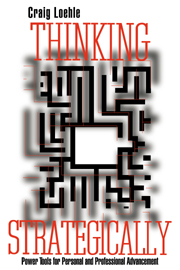PART 1 - Component skills of strategic thinking
Published online by Cambridge University Press: 24 September 2009
Summary
Because strategic thinking is inherently about open-ended, complex problems, it is not possible to apply a “cookbook” approach. Rather, one must have a general approach to problem solving that is effective. For those who are not born strategists, this involves tuning up one's thinking machinery specifically for this type of problem. In particular, there are three steps to creating successful novel products. First, one must be capable of generating novel (but useful) ideas, of overcoming routine ways of functioning, and of putting together information in new ways. Without this capacity, one is limited to solving problems defined by others (my definition of a drone). Second, one must be able to use this creative capacity to discover/invent something new. This can be, for example, a new style of art, a new computer algorithm, a new building design, an improvement to a video recorder, or a new type of restaurant. Third, one must understand how to structure work to bring a new creation to fruition. Without this third step, one is just daydreaming.
In this section I show how one enhances the creative process, how one goes about making discoveries, how one puts together the solution to a complex problem, how one tests the solution one obtains, and how one enhances internal mental states for optimal performance. What is most noteworthy is that the conventional wisdom in all of these domains fails in the face of complexity.
- Type
- Chapter
- Information
- Thinking StrategicallyPower Tools for Personal and Professional Advancement, pp. 7 - 8Publisher: Cambridge University PressPrint publication year: 1996



